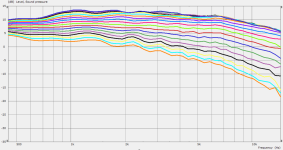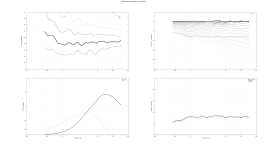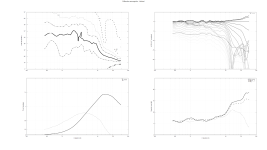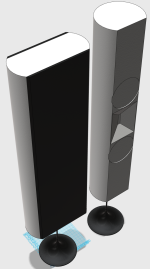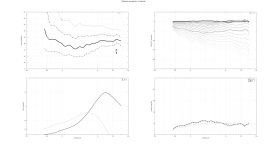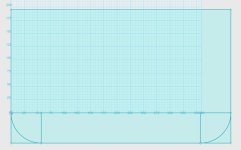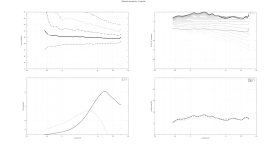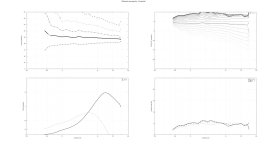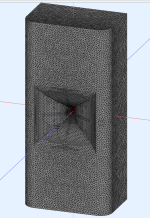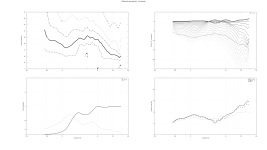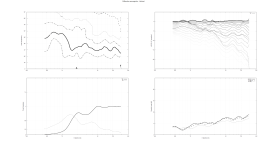2018-2025 Stayin' alive! 😆
I like the Sonotube idea. If you squished the tube to an egg shape it might be better? Another idea, if you could somehow cut the Sonotube in a slice from the woofer down to a point you could approximate the shape of the Blade.
I like the Sonotube idea. If you squished the tube to an egg shape it might be better? Another idea, if you could somehow cut the Sonotube in a slice from the woofer down to a point you could approximate the shape of the Blade.
These ribbons seem to work really well on waveguides. I don't normally see curves this smooth.
Here's the latest version; it uses the newer enclosure shape, pictured on the previous page. The enclosure that's basically a 4x1 Ikea Kallax shelf that's been cut in half.
; March 3rd 2025 NeoX2.0 waveguide
HornGeometry = 2
Length = 101.6
;Rot = 3.26
Horn.Adapter = {
L = 0
Width = 12
Height = 62
Segments = 0
}
Horn.Part:1 = {
L = 5
Segments = 1
H = {
r0 = 6
a0 = 0
a = 0
k = 0
}
V = {
r0 = 31
a0 = 0
a = 0
k = 0
}
}
Horn.Part:2 = {
L = 5
Segments = 1
H = {
r0 = 6
a0 = 45
a = 45
k = 0
}
V = {
r0 = 31
a0 = 0
a = 0
k = 0
}
}
Horn.Part:3 = {
L = 91.6
Segments = 16
H = {
r0 = 11
a0 = 45
k = 1.3
s = 1.32
a = 47.5
n = 4.5
q = 0.996
}
V = {
r0 = 31
a0 = 0
k = 1.3
a = 63
s = 1.32
n = 4.03
q = 0.996
}
ZMap = 0.5,0.3,0.5,0.9
}
cylinder_wg = {
point P0 188.45 0 10
point P1 207.5 19.05 10
point P2 207.5 214.05 20
point P3 188.45 233.1 20
point PB 0 233.1 20
cpoint C1 135.6 116.55
line P0 P1
arc P1 C1 P2
;line P1 P2
line P2 P3
line P3 PB
}
Mesh.Enclosure = {
Plan = cylinder_wg
Spacing = 5, 250, 5, 250
;Depth = 200
;EdgeRadius = 25
;EdgeType = 1
;FrontResolution = 8,8,16,16
;BackResolution = 20,20,20,20
}
Mesh.AngularSegments = 64
Mesh.LengthSegments = 36
Mesh.SubdomainSlices =
;Mesh.InterfaceOffset = 8.0
Mesh.Quadrants = 1
Mesh.ThroatResolution = 3
Mesh.MouthResolution = 8
ABEC.SimType = 2
ABEC.f1 = 450; [Hz]
ABEC.f2 = 14400; [Hz]
ABEC.NumFrequencies = 51
ABEC.MeshFrequency = 1000 ; [Hz]
ABEC.Polars:SPL_H = {
MapAngleRange = 0,90,19
Distance = 3 ; [m]
Offset = 102.6
}
ABEC.Polars:SPL_V = {
MapAngleRange = 0,90,19
Distance = 3 ; [m]
Offset = 102.6
Inclination = 90
}
Output.ABECProject = 1
Output.STL = 1
Report = {
PolarData = "SPL_H"
Title = "Diffraction waveguide - Horizontal"
Width = 2880
Height = 1620
;MaxAngle = 0
NormAngle = 10
}
Here's the latest version; it uses the newer enclosure shape, pictured on the previous page. The enclosure that's basically a 4x1 Ikea Kallax shelf that's been cut in half.
; March 3rd 2025 NeoX2.0 waveguide
HornGeometry = 2
Length = 101.6
;Rot = 3.26
Horn.Adapter = {
L = 0
Width = 12
Height = 62
Segments = 0
}
Horn.Part:1 = {
L = 5
Segments = 1
H = {
r0 = 6
a0 = 0
a = 0
k = 0
}
V = {
r0 = 31
a0 = 0
a = 0
k = 0
}
}
Horn.Part:2 = {
L = 5
Segments = 1
H = {
r0 = 6
a0 = 45
a = 45
k = 0
}
V = {
r0 = 31
a0 = 0
a = 0
k = 0
}
}
Horn.Part:3 = {
L = 91.6
Segments = 16
H = {
r0 = 11
a0 = 45
k = 1.3
s = 1.32
a = 47.5
n = 4.5
q = 0.996
}
V = {
r0 = 31
a0 = 0
k = 1.3
a = 63
s = 1.32
n = 4.03
q = 0.996
}
ZMap = 0.5,0.3,0.5,0.9
}
cylinder_wg = {
point P0 188.45 0 10
point P1 207.5 19.05 10
point P2 207.5 214.05 20
point P3 188.45 233.1 20
point PB 0 233.1 20
cpoint C1 135.6 116.55
line P0 P1
arc P1 C1 P2
;line P1 P2
line P2 P3
line P3 PB
}
Mesh.Enclosure = {
Plan = cylinder_wg
Spacing = 5, 250, 5, 250
;Depth = 200
;EdgeRadius = 25
;EdgeType = 1
;FrontResolution = 8,8,16,16
;BackResolution = 20,20,20,20
}
Mesh.AngularSegments = 64
Mesh.LengthSegments = 36
Mesh.SubdomainSlices =
;Mesh.InterfaceOffset = 8.0
Mesh.Quadrants = 1
Mesh.ThroatResolution = 3
Mesh.MouthResolution = 8
ABEC.SimType = 2
ABEC.f1 = 450; [Hz]
ABEC.f2 = 14400; [Hz]
ABEC.NumFrequencies = 51
ABEC.MeshFrequency = 1000 ; [Hz]
ABEC.Polars:SPL_H = {
MapAngleRange = 0,90,19
Distance = 3 ; [m]
Offset = 102.6
}
ABEC.Polars:SPL_V = {
MapAngleRange = 0,90,19
Distance = 3 ; [m]
Offset = 102.6
Inclination = 90
}
Output.ABECProject = 1
Output.STL = 1
Report = {
PolarData = "SPL_H"
Title = "Diffraction waveguide - Horizontal"
Width = 2880
Height = 1620
;MaxAngle = 0
NormAngle = 10
}
Attachments
I'm converging on a final design. Here's a comparison of the horizontal response of two nearly identical ribbon waveguides for the NeoX 2.0
One is 88.9mm deep (3.5") and one is 101.6mm deep (4")
One is 88.9mm deep (3.5") and one is 101.6mm deep (4")
Attachments
Attached is a pic of the sketch that's used to make the enclosure. It's basically a flat baffle with a roundover that's 4.5" in diameter. You can create that roundover by cutting 4" schedule 40 PVC into four pieces.
So far, this is the "winning" design, it's the one that's 4" deep from my previous post today.
; April 9th 2025 NeoX2.0 waveguide
HornGeometry = 2
Length = 101.6
;Rot = 3.26
Horn.Adapter = {
L = 0
Width = 12
Height = 62
Segments = 0
}
Horn.Part:1 = {
L = 5
Segments = 1
H = {
r0 = 6
a0 = 0
a = 0
k = 0
}
V = {
r0 = 31
a0 = 0
a = 0
k = 0
}
}
Horn.Part:2 = {
L = 5
Segments = 1
H = {
r0 = 6
a0 = 45
a = 45
k = 0
}
V = {
r0 = 31
a0 = 0
a = 0
k = 0
}
}
Horn.Part:3 = {
L = 91.6
Segments = 16
H = {
s = 0.62
q = 0.995
n = 4.5
r = 11
t = 10
a0 = 45
a = 47.5
}
V = {
s = 1.62
q = 0.995
n = 4.5
r = 11
t = 10
a0 = 0
a = 20
}
ZMap = 0.5,0.3,0.5,0.9
}
cylinder_wg = {
point P0 150.5 0 10
point P1 207.5 57 12
point P2 207.5 252 20
point PB 0 252 20
cpoint C1 150.5 57
arc P0 C1 P1
line P1 P2
line P2 PB
}
Mesh.Enclosure = {
Plan = cylinder_wg
Spacing = 5, 300, 5, 300
;Depth = 200
;EdgeRadius = 25
;EdgeType = 1
;FrontResolution = 8,8,16,16
;BackResolution = 20,20,20,20
}
Mesh.AngularSegments = 64
Mesh.LengthSegments = 36
Mesh.SubdomainSlices =
;Mesh.InterfaceOffset = 8.0
Mesh.Quadrants = 1
Mesh.ThroatResolution = 3
Mesh.MouthResolution = 8
ABEC.SimType = 2
ABEC.f1 = 450; [Hz]
ABEC.f2 = 14400; [Hz]
ABEC.NumFrequencies = 51
ABEC.MeshFrequency = 1000 ; [Hz]
ABEC.Polars:SPL_H = {
MapAngleRange = 0,90,19
Distance = 3 ; [m]
Offset = 102.6
}
ABEC.Polars:SPL_V = {
MapAngleRange = 0,90,19
Distance = 3 ; [m]
Offset = 102.6
Inclination = 90
}
Output.ABECProject = 1
Output.STL = 1
Report = {
PolarData = "SPL_V"
Title = "Diffraction waveguide - Vertical"
Width = 2880
Height = 1620
;MaxAngle = 0
NormAngle = 10
}
So far, this is the "winning" design, it's the one that's 4" deep from my previous post today.
; April 9th 2025 NeoX2.0 waveguide
HornGeometry = 2
Length = 101.6
;Rot = 3.26
Horn.Adapter = {
L = 0
Width = 12
Height = 62
Segments = 0
}
Horn.Part:1 = {
L = 5
Segments = 1
H = {
r0 = 6
a0 = 0
a = 0
k = 0
}
V = {
r0 = 31
a0 = 0
a = 0
k = 0
}
}
Horn.Part:2 = {
L = 5
Segments = 1
H = {
r0 = 6
a0 = 45
a = 45
k = 0
}
V = {
r0 = 31
a0 = 0
a = 0
k = 0
}
}
Horn.Part:3 = {
L = 91.6
Segments = 16
H = {
s = 0.62
q = 0.995
n = 4.5
r = 11
t = 10
a0 = 45
a = 47.5
}
V = {
s = 1.62
q = 0.995
n = 4.5
r = 11
t = 10
a0 = 0
a = 20
}
ZMap = 0.5,0.3,0.5,0.9
}
cylinder_wg = {
point P0 150.5 0 10
point P1 207.5 57 12
point P2 207.5 252 20
point PB 0 252 20
cpoint C1 150.5 57
arc P0 C1 P1
line P1 P2
line P2 PB
}
Mesh.Enclosure = {
Plan = cylinder_wg
Spacing = 5, 300, 5, 300
;Depth = 200
;EdgeRadius = 25
;EdgeType = 1
;FrontResolution = 8,8,16,16
;BackResolution = 20,20,20,20
}
Mesh.AngularSegments = 64
Mesh.LengthSegments = 36
Mesh.SubdomainSlices =
;Mesh.InterfaceOffset = 8.0
Mesh.Quadrants = 1
Mesh.ThroatResolution = 3
Mesh.MouthResolution = 8
ABEC.SimType = 2
ABEC.f1 = 450; [Hz]
ABEC.f2 = 14400; [Hz]
ABEC.NumFrequencies = 51
ABEC.MeshFrequency = 1000 ; [Hz]
ABEC.Polars:SPL_H = {
MapAngleRange = 0,90,19
Distance = 3 ; [m]
Offset = 102.6
}
ABEC.Polars:SPL_V = {
MapAngleRange = 0,90,19
Distance = 3 ; [m]
Offset = 102.6
Inclination = 90
}
Output.ABECProject = 1
Output.STL = 1
Report = {
PolarData = "SPL_V"
Title = "Diffraction waveguide - Vertical"
Width = 2880
Height = 1620
;MaxAngle = 0
NormAngle = 10
}
Attachments
so what is better according to the graphs
The one that's 101.6mm deep
I found something interesting with these ribbon waveguides:
Because they perform so well off-axis, you could potentially listen to them cross-fired.
Geddes recommends this with his Summa speakers; the idea is that the right speaker is a full 45 degrees off axis, so that the two speakers cross in front of the listener instead of AT the listener or behind them.
By crossfiring them, you get late reflections off of the side walls, which can make the stage sound wider and deeper.
Attached are two of the recent designs but simulated a full 45 degrees off axis. You'll notice that when cross fired, the speaker is actually LOUDER off-axis than ON axis. The idea here is that you can walk from left to right in the room, and as you move to the RIGHT the LEFT speaker gets LOUDER. And vice versa. This 'trick' keeps the soundstage centered even when listening off-axis.
I tried to illustrate this here, sixteen years ago: https://www.diymobileaudio.com/threads/creating-the-perfect-soundstage.60146/
Because they perform so well off-axis, you could potentially listen to them cross-fired.
Geddes recommends this with his Summa speakers; the idea is that the right speaker is a full 45 degrees off axis, so that the two speakers cross in front of the listener instead of AT the listener or behind them.
By crossfiring them, you get late reflections off of the side walls, which can make the stage sound wider and deeper.
Attached are two of the recent designs but simulated a full 45 degrees off axis. You'll notice that when cross fired, the speaker is actually LOUDER off-axis than ON axis. The idea here is that you can walk from left to right in the room, and as you move to the RIGHT the LEFT speaker gets LOUDER. And vice versa. This 'trick' keeps the soundstage centered even when listening off-axis.
I tried to illustrate this here, sixteen years ago: https://www.diymobileaudio.com/threads/creating-the-perfect-soundstage.60146/
Attachments
I was curious to see if a compression driver with a diffraction slot could be as smooth as a ribbon. The idea here, is:
1) We know for a fact that a ribbon tweeter has a flat rectangular wavefront at the throat, because the diaphragm is flat and rectangular
2) Theoretically, a diffraction slot should act similar. But it doesn't, because the diffraction slot doesn't produce a wavefront that's perfectly flat and rectangular. The diffraction slot 'squashes' the wavefront that isn't properly flat.
Attached are the horizontal sims, the vertical sims, and a render of the enclosure. But I wouldn't build this one, it doesn't perform very well.
1) We know for a fact that a ribbon tweeter has a flat rectangular wavefront at the throat, because the diaphragm is flat and rectangular
2) Theoretically, a diffraction slot should act similar. But it doesn't, because the diffraction slot doesn't produce a wavefront that's perfectly flat and rectangular. The diffraction slot 'squashes' the wavefront that isn't properly flat.
Attached are the horizontal sims, the vertical sims, and a render of the enclosure. But I wouldn't build this one, it doesn't perform very well.
Attachments
Only way to find out is to attach a compression driver to one of your lens that was designed for the ribbon driver , maybe you will need to make an adaptor , but that will tell if the reshaping of the compression driver will affect the freq response curve, or maybe add a rectangular window in front of the compression driver to mimick the ribbon.?
- Home
- Loudspeakers
- Multi-Way
- Ribbon Unity Horn
